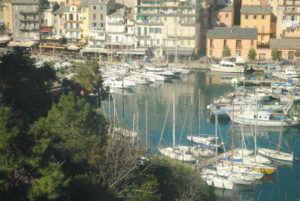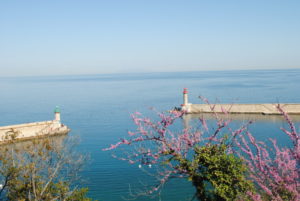
Among pirates and violent offenders
41° 40′ 34.4028” N 8° 54′ 3.4524” E
Wednesday 21th of june to Sunday 25th of June
Fantastic sailing day! We set off from Cargése in the early morning and immediately set sail, even though the wind is weak, and now it’s time for morning coffee. The wind increases during the day, and eight hours later we reach Porto Pollo after an absolutely enchanting day at sea. Dolphins have played alongside the boat. One mountain scenery has replaced the next.
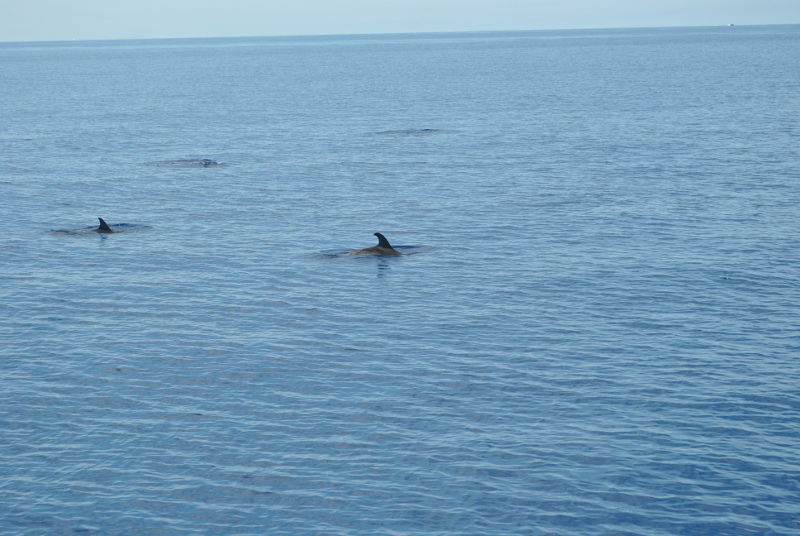
Dancing with Ronja. Five or seven dolphins (or porpoises?) kept dancing and playing around us for a quite a while.
Porto Pollo means “the troubled port”, and it got its name many years ago, when the city was a favourite target for pirates in the area. You don’t see many pirates these days, but the city is obviously preparing for a giant invasion of sailing tourists.
The town itself is small, almost dried up – and honestly quite boring – with its only 100 permanent inhabitants. On the other hand, it is blessed with mile-long beaches, and along these hundreds of buoys are laid out to welcome the invasion of sailors.
We are here outside high season, so less than every tenth buoy is occupied. The price for a buoy outside high season: 20 €.
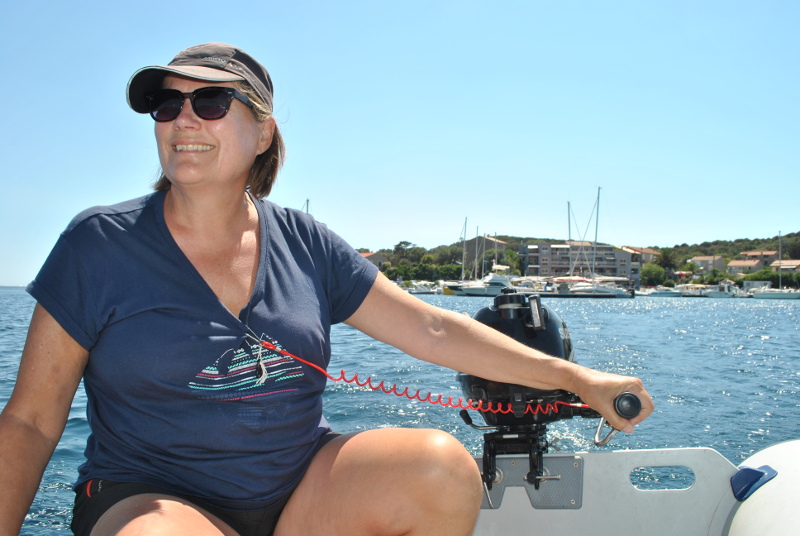
Skippers wife is taking charge. Conquering the steering hand at the inflatable boat. It was bound to happen some day.
After two days of lazy life outside the Porto Pollo beach, we head for Propriano – a bigger city with a real port and 3200 inhabitants.
As always, we prepare ourselves for a new destination, and read in the guidebook, about a dynamic coastal city with a maritime atmosphere and great beach life. In our “bible” during the sailing trip – “Mediterranean France & Corsica Pilot” by Rod Heikell – we find a different and more interesting angle. He writes, that for decades Propriano has had a dubious reputation. In the 1950s, the city was referred to as a city to avoid, where innocent locals were being murdered, and a local fisherman killed the Coast Guard, when he was charged for fishing with dynamite.
Propriano apparently has a large catalogue of violent crimes. As late as april 1990, the liberation movement, FLNC, blew one of the city’s restaurants up.
We ourselves experienced the city as quite peaceful. Good restaurants. Nice beaches. And amiable Frenchmen.
Bonus info: Try eating at Tempi Fa, close to the harbour. It is – according to Tripadvisor – the 39th best of 2,192 restaurants in Corsica – if you rely on review sites like that. During the daytime Tempi Fa offers wine and tapas and in the evening solid Corsican dinner dishes far behind the wine cellar. Tempi Fa is build around a wine bar with exclusively Corsican wines. We had the best red wine so far on our entire time in Corsica. Granite is the name of the wine. Very complex. Full of character. It is an appellation Ajaccio Protégée, but it is produced close to Propriano, which does not have its own appellation. A votre santé!
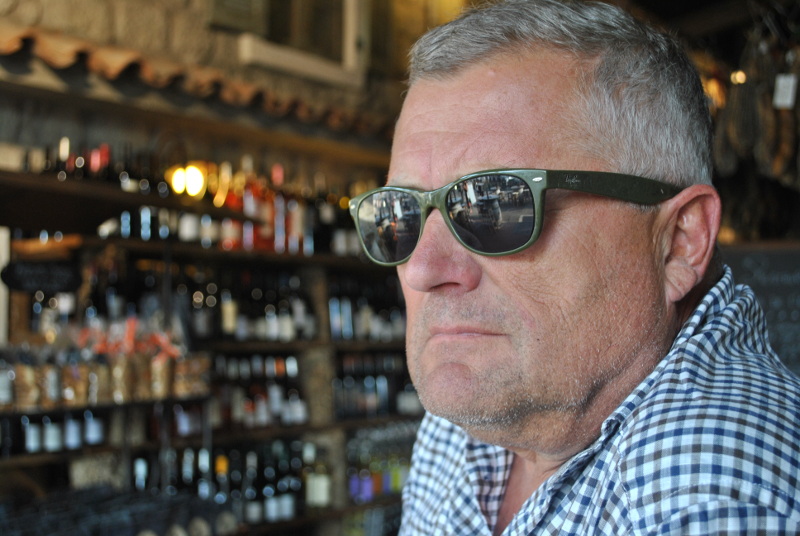
Time for reflexion. A cellar full of only corsican wine. Some of them are thougt-provokingly good.
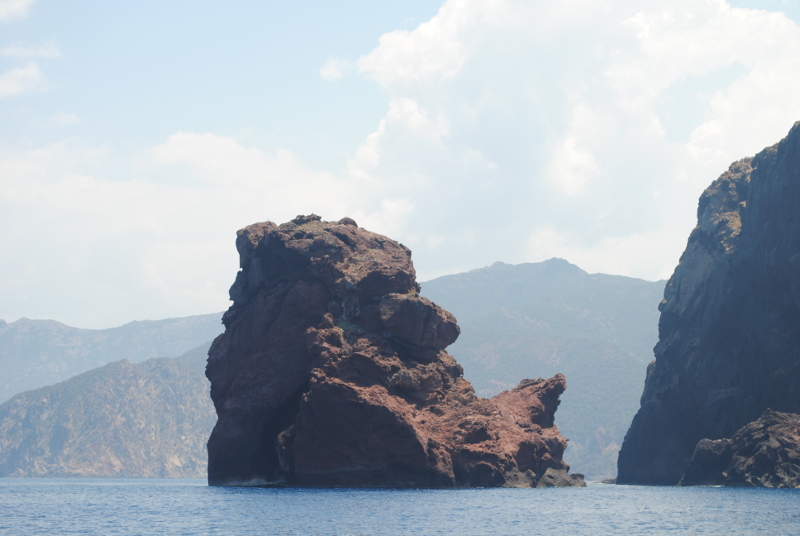
Calvi has become too wild. We must continue
42° 20′ 55.7988” N 8° 36′ 51.5808” E
June 16, 2017
It’s becoming summer in Calvi. It’s mid June, the temperature is buzzing close to 30 degrees, the beachgoers flood the beach, and all over the harbour disco rhythms blast all night in an attempt to whip up an early summer atmosphere.
After having been in Denmark for almost two months, we arrive in a transformed city. Most of the snow is melted on the Corsican mountains, and everywhere Calvi is enjoying more life, than when we left Ronja on a rack at the pickup site, Chantier Navale, at the end of April.
Calvi has become too much for those of us, who enjoy a good night’s sleep. We must continue.
The next stop becomes Girolata, which is not a port but a protected bay with laid out buoys in a pattern resembling a port. You are assigned to a spot by helpful port assistants in inflatable boats that take care of attaching rope to buoys front and rear. We are close to the other boats in an exceptional beautiful landscape with brown dairy cattle on the beach, primitive restauration shacks – all surrounded by beautiful mountains, and after the tour boats have brought the last tourists back to civilization, we are even blessed with a divine silence.
It costs 31 euros for one night. Well, for two buoys and an infinite silence for the hole night. Sometimes that’s worth 31 euros.

The bars and restaurants at Girolata beach are rather Klondyke-like, with only wooden buildings
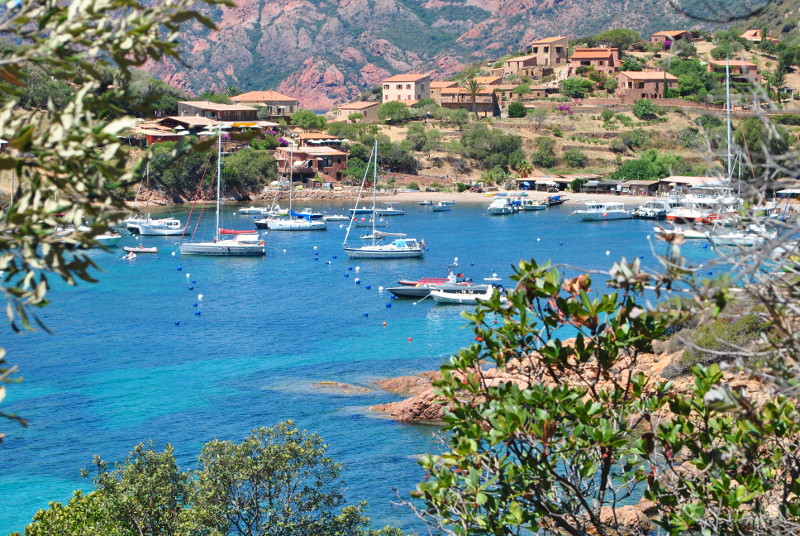
Girolata is actually a small well protected cove inside a larger cove. Buoys are laid out in the pattern of a harbour. Side by side. With a rope fore and aft
We stay for two nights, and we go for walks in the nearby mountains. On Tuesday we continue to Cargése, a small harbour with room for only 12-15 boats in addition to the permanent occupants. Cargése is a Greek-inspired mountain village with Greek Catholic churches. The location is wonderful. But otherwise we are most affected by the fact, that it is less than ideal for shopping. First, you climb a mountain under the burning sun to reach the local Spar supermarket at the top of the mountain, and then you clamber down the mountain again with your stuffed shopping bags.

View from the small town Cargése
Bonus info: Should you ever use a port for some months in Corsica, while you are at home, Calvi is a good bet. Chantier Navale, the local pick up space, stores your boat at an acceptable price, and if you need to have small jobs done on the boat, then Dumé, the practical guy on the spot is more than ordinarily friendly, totally reliable and capable of getting things done. Only “minus” is, that he speaks only French. Great guy.
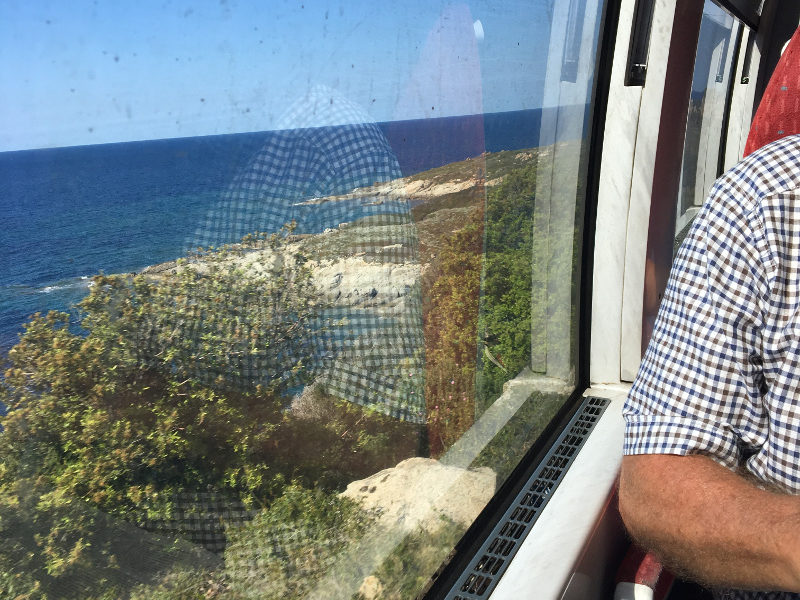
Probably the world’s most beautiful train journey
41° 55′ 9.2244” N 8° 44′ 19.086” E
21- April 23, 2017
When sailors go ashore, they take the train. At least if they go ashore in the city of Calvi in Corsica, and the plane to Denmark is leaving Ajaccio, a little further south in Corsica. By car there is 72 kilometers according to Google Maps. By train the journey lasts five hours. We choose the train.
Many have enthusiastically told us about the small Corsican trains that slide along the coast on narrow shines, creep up the mountains, and make great detours around the mountains to avoid the route beeing to steep.
We are not disappointed. If I was the owner of the railroad, I would order the train windows washed every single day, because a trip with these trains is really a spectacular attraction.
I think such a train journey tells you much of what you need to know about Corsica. About unbelievable beauty in the mountains, about scattered flocks of goats and cows and occasionally – but only rarely – a piece of cultivated soil. The tour brings you through small mountain towns, where you can hardly understand, how the inhabitants can earn a living. Scattered carvrecks and padded mattresses do not seriously obscure the image of Corsica’s overwhelming beauty.
On fallow buildings we see graffiti with slogans of freedom and autonomy for Corsica. We are struggling to understand how an independent Corsica can match the island’s huge unemployment and an annual net cash transfer from mainland France. Corsica currently lives by tourists and not much else.
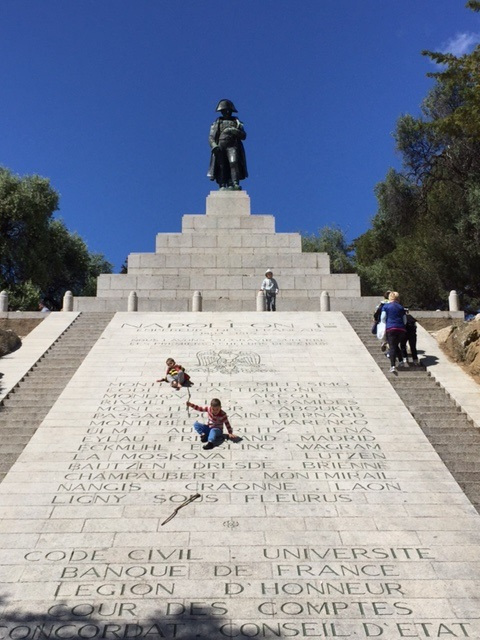
Many french cities claim to have had a special relation to Napoleon Bonaparte. Also Ajaccio where Napoleon was born and lived his first nine years
We have a day and a half in Ajaccio (pronounced asjakio, we are taught) before the flight home. It is a big city after Corsican standards. It may be that people in Bastia think that they are the ones behind the dynamics of the Corsican economy. But it is not thruu. Ajaccio is the island’s capital. It is not particularly beautiful. But it is humming of activity and many visitors. We in particular liked the city’s busy food market and a couple of excellent museums.
Bonus info: Eat at the restaurant Le Roi de Rome. It is rated by TripAdvisor to be the 29th best among 2408 Corsican restaurants. The food is excellent, the owner understands Corsican wine, and the prices are absolutely fair. Also take a trip with the city’s “petit train”. You may feel a little silly sitting a kind of children’s train, but it will take you to places in the area where you would hardly get on foot.
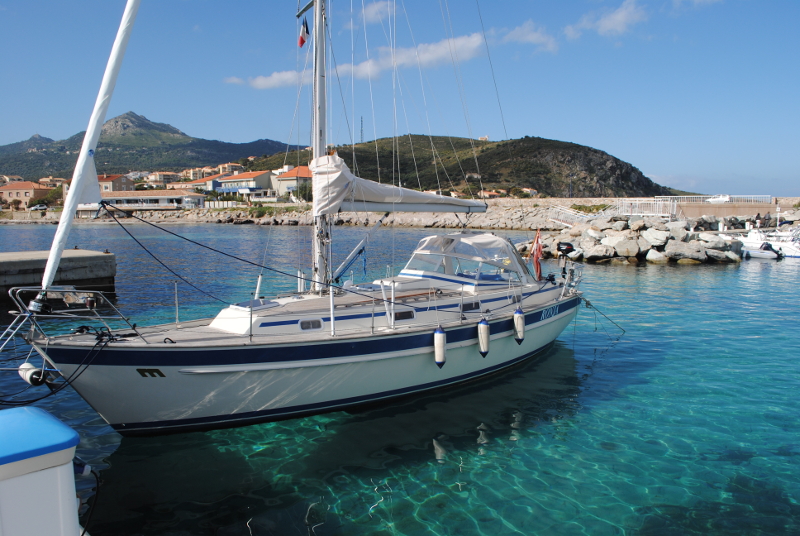
I’le Rousse is not for sailors
42° 38′ 23.028” N 8° 56′ 9.7548” E
17th – 19th of April, 2017
We sailed to I’le Rousse, which we actually passed several days ago on our way to Calvi. Good friends let us know that I’le Rousse is a must-see. It is one of the pearls in northwest Corsica, and if we are to see the city, it must be now before we get too far south.
The arrival of I’le Rousse is a disappointment. The harbour is narrow, badly marked, not very deep, and as we pull up the lines from the buttom of the marina to secure Ronja, it is obvious that these lines have not been used for half a year. Clusters of clams and razor sharp small shellfish cling to the lines and tear our hands to blood.
The outer bassin is a big ferry port. The inner bassin is a small boat marina for small fishinboats and dinghies. Small keelboats like ours do not get any protection here.
We hurry into the city to get balanced our first impression of Île Rousse. There must be something good? There is. Île Rousse turns out to be a charming city. Old men play petanque on the city’s peculiarly oversized square, groups of elderly enjoy a pastiche at the sidewalk cafe, and German tourists throw a beer while studying Lonely Planet and preparing to tension the motorcycle helmet for new experiences.
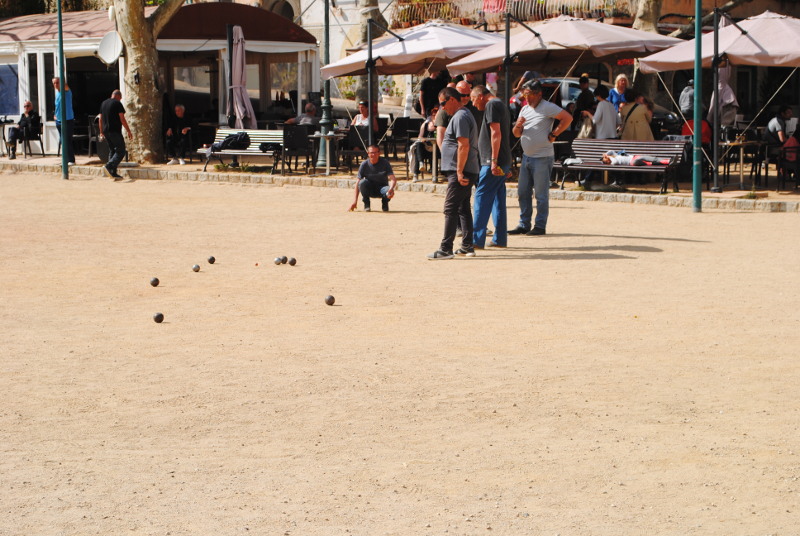
In April, Île Rousse is the Corsicans own town. They characterize the cityscape, set the pace, create the mood. We think that in the summer it is probably the other way around. Then the tourists fill the whole, the many small hotels, the beach restaurants, the white sandy beaches, the many play possibilities on the water in the bay.
The city is easy to overlook. It has a daily food market and good shops. It has a bit of the same as Calvi, just in a smaller version.
Possibly it also has good walking routes along the water, but the tourist office could not enlighten us on this. “Ask in a bookshop,” they told us followed by a: “By the way, bookshops are closed today due to the easter”
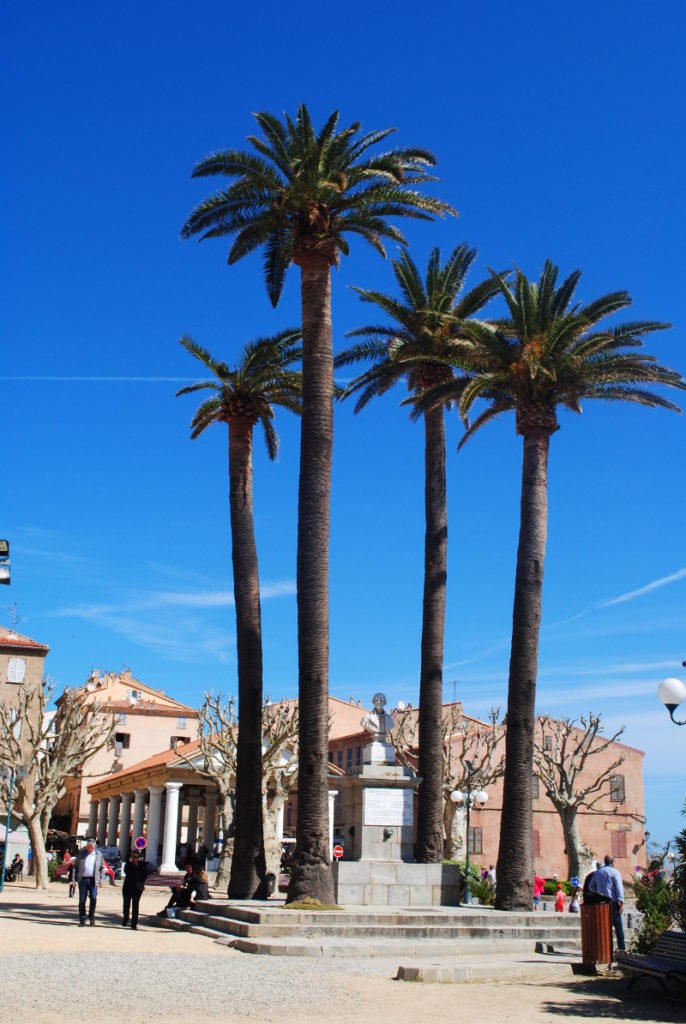
Back in the harbour a storm is getting closer. “It will be at least Beaufort 7“, says the harbour captain. “It’s going to be bad, bad,” he adds. We are his only customer for two days. Others talk about a 40 knot gale, and we convert as usual to our own scale, which says 21 meters pr second from the northwest.
That’s a lot.
The harbour is not built for 21 meters pr second from the northwest. We realised this too late. We did take our precautionary measures. We tightened the aft moorings, we loosened up the bow moorings to keep us away from the quayside, we mounted a fender in Ronja’s bow, we kept distance to the fleets of watercrafts and pedalos that had been pulled into storm safety in the marina.
None of this, however, took into account the ragnarok that came to affect the night. Wild, violent, abrupt pulls in the moorings. Noise and shutterings. No an eye is closed. We try everything to adjust the moorings, and we are awake all night thinking, that Ronja has not deserved this. Poor Ronja
The marina of Île Rousse is a scandal. The worst we have met for several years.
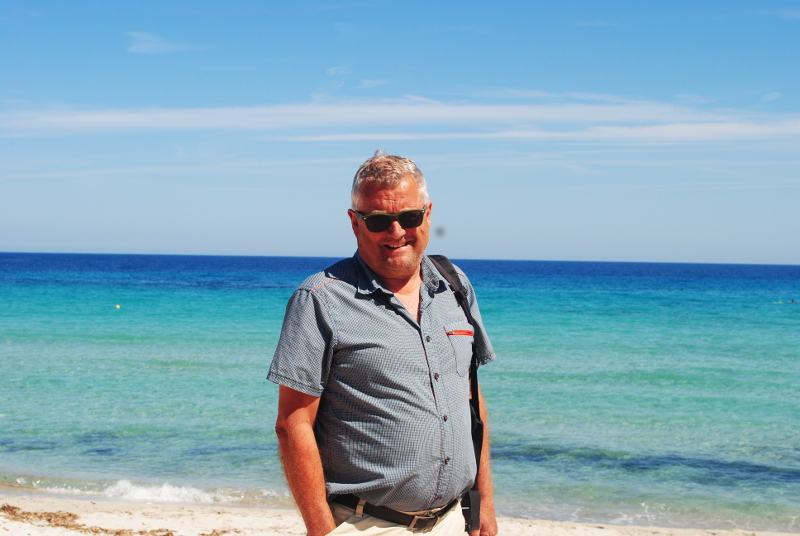
If a weather forecast promises wind from the northwest, keep far away from île Rousse. Sail to Calvi, sail to the mainland, sail anywhere, but avoid île Rousse. The marina is incorrectly constructed. It is a concrete pier, but it is built as a pontoon pier, with large holes in the structure that allow any wave to hammer across the harbor with full strength.
At the same time the marina does not have any qualities of the usual kind – decent showers, toilets, help from the harbour office. Forget that harbor. Sail on. Lovely town. But not for people of the sea.

Tough waters with mirror polished surface
42° 40′ 47.1468” N 9° 17′ 57.2208” E
April 11, 2017
Cap Corse – the northern tip of Corsica – is a waterway that has a reputation of beeing wild and dangerous. We are told, that it can be a tough water, where strong wind gets up out of nowhere and makes the passage between the coast of Corsica and the small island, Île de la Giraglia, difficult.
We see nothing of the sort. The Mediterranean breathes peace with a surface that is close to being mirror. Our Yanmar engine does cope with the work to round Cap Corse. Our only challenge is to avoid the many fishing flags in the area.

Our goal is St. Florent. A small resort town that in our guidebooks is referred to as a mini version of the more famous resort of Calvi. The comparison does not hold.

St. Florent is well protected at the bottom of a bay. It is a relatively large port, pretty expensive (84 euros for two nights in peak season), a moderate restaurant scene, a dull citadel and a beach that consists of nothing but stones. The city prides itself however that ten kilometers west of the city lies a fantastic sandy beach, Saleccia, who in 1961 was the setting for a movie with Robert Mitchum starring on the allied troops’ invasion of Normandy. “The longest day” was the name of the film.
After two days we leave St. Florent and head for Calvi.

In the footsteps of the customs officers
42° 57′ 32.5404” N 9° 27′ 19.584” E
April 10, 2017
The northern tip of Corsica, Cap Corse, has a very welcoming nature, where the mountains are greener and more gently rounded than the mountains, we can see further into the island. We sail into the small town of Macinaggio (Macinagjhju in Corsican). Since Bastia we have had to friends from Denmark, Helen and Mikkel, onboard Ronja.

The harbour master has gone on weekend, and however much we would love to pay for our accommodation, we never get a chance to to it.
The town is small, cozy and is obviously depending upon tourists to create life in the 20 restaurants that are all placed along the seafront.

Outside the city, along the coast, it is possible to hike. A narrow path follows the shoreline around among the few cities, and the scenery along the path is matchless. Follow “Sentier des douaniers”, the original path of the customs officers from which they by foot were watching the coast of Corsica.
You can choose between walks in two hours and up to eight hours. Whatever: The tour is fantastic.

Corsica says welcome
42° 41′ 44.4948” N 9° 27′ 3.9024” E
April 7 to 9, 2017
A tired little bird takes a short rest in our cockpit in the middle of the sea between Elba and Corsica, but otherwise today’s 38 nautical miles are rather uneventful, until we just outside the Corsican port city of Bastia is welcomed by three to four dolphins, that swim fast under our boat and make enthusiastic leaps out of the water.
What a welcome.
We sail past the large ferry harbour and slip into the old port. We are assigned an excellent berth for just 73 euros for three nights (yes, we are back in France). The port appears not only to be cheap, it is also exciting. From morning to night there is a busy traffic of fishermen, divers, customs officers, sailing schools and local yachtsmen who slips past the harbour to check the moorings on their boat, now that the season are approaching.

The crew for North- and Northwest Corsica: Skipper (right) and longtime danish friends Mikkel and Helen
We immediately likes the city – especially the area around the old port. The harbour neighborhood is the oldest part of town, and it is obvious Italian inspired and reminiscent in many ways of Genoa with tall buildings and narrow alleys. The town’s citadel is restored and converted into a museum, which is certainly worth a visit.
- Vieux Port. Find Ronja!
- A view from The Citadel
Saturday and Sunday there is a market in Place du Marché, where we buy vegetables, meats, breads, cheeses and herbs. Bastia has 44,000 inhabitants. But when you walk around in it, you get the feeling of a major city.
Bastia has for centuries been in rivalry with Ajaccio about being Corsica’s capital. But Napoleon Bonaparte did not like Bastia, so he made Ajaccio the island’s capital and defeated with an iron fist a rebellion by the inhabitants of Bastia. Since then, the competition between the two cities only have verbal character. The inhabitants of Bastia looks upon Ajaccio as a dusty administrative town, while Bastia in their own perception is the dynamic commercial town that keeps the Corsican economy afloat.
Bonus Info: Taste the Corsican beer made on chestnuts. It is called Pietra (rock), ant it is surprisingly good. Corsica is not known as a beer-country, but in 1996 some people in Bastia began to brew a local beer, which has since become a great succes in Corsica.
